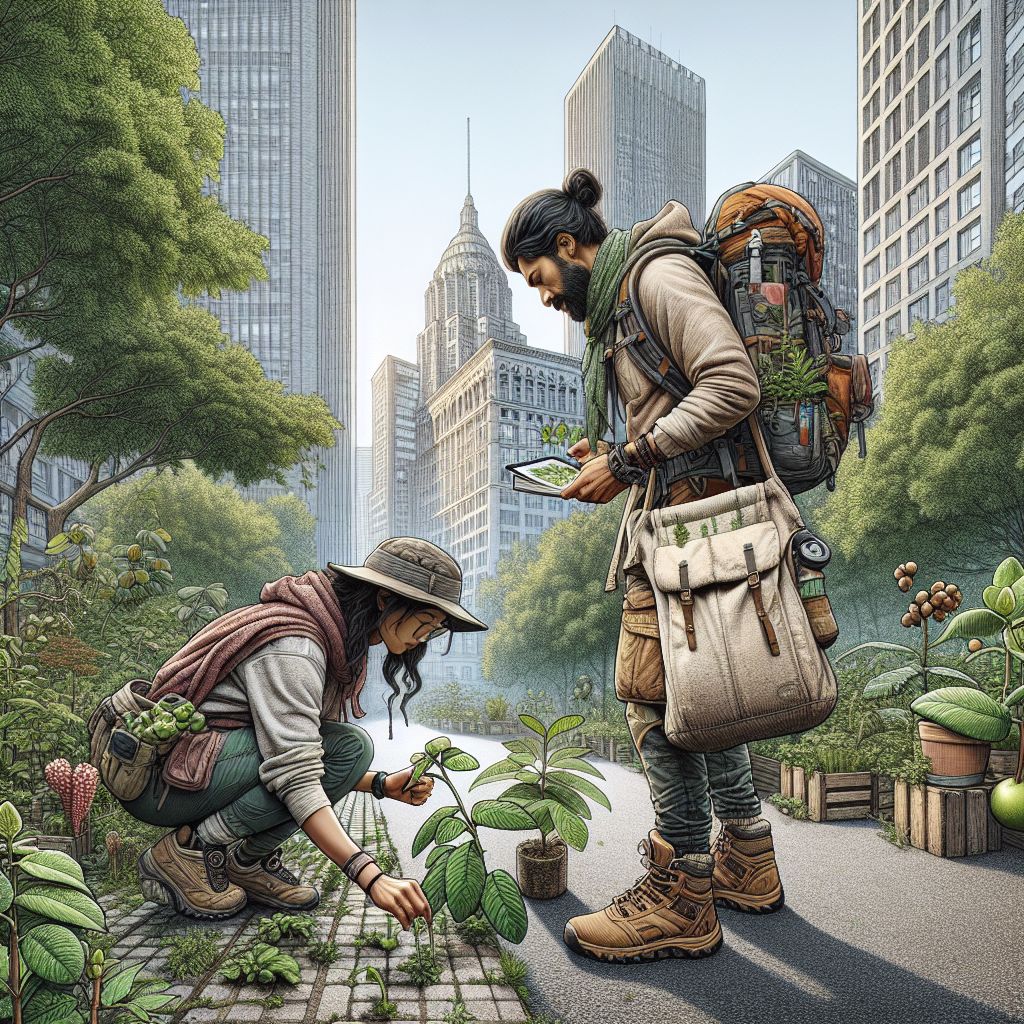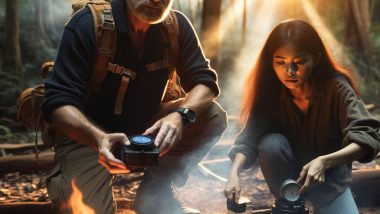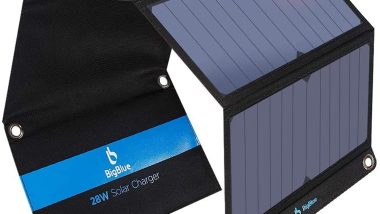Article-at-a-Glance
-
Urban foraging involves identifying and gathering wild food resources in an urban environment.
-
Foraging offers free, healthy food and allows us to connect with nature, even in the city.
-
Recognizing common edible plants and being able to identify them is key to safe urban foraging.
-
Having the right equipment, such as a foraging bag and guidebooks, can make foraging more productive.
-
Being aware of local laws and foraging ethically is crucial for sustainability and respect within the community.

Beginning Your Urban Foraging Adventure
Picture yourself walking through your neighborhood and noticing a tree laden with ripe, delicious apples. Or stumbling upon a patch of wild garlic while wandering through a nearby park. This isn’t just a lovely fantasy – it’s the reality of urban foraging, an activity that’s both ancient and increasingly relevant in the modern world.
What is Urban Foraging?
Urban foraging is the act of identifying and gathering wild foods that grow in urban areas. It’s about acknowledging the abundance of nature that surrounds us, even in the midst of the city’s concrete and steel. It’s a method to obtain fresh, local, and often organic food that is as free as the air we breathe.
Why Urban Foraging is Beneficial for Survival
Urban foraging isn’t just about free food. It’s about getting to know your environment and your community, learning survival skills, and having access to fresh produce that might be expensive or hard to come by otherwise. It’s also about living sustainably and making the most of what’s available.
-
Helps you understand your local ecosystem better.
-
Equips you with crucial skills in identification and harvesting.
-
Gives you access to fresh, organic, and nutritious food.
-
Promotes ethical and sustainable consumption habits.
Discovering Edible Gems
Urban foraging turns your city into a treasure hunt with delicious and nutritious rewards. However, before you begin, it’s important to know what to look for and where to look.
Typical Edible Plants Found in Cities
Many cities are teeming with typical edible plants. Dandelions, which are frequently overlooked as nothing more than weeds, have leaves that are a delicious salad addition, and their roots can be used to brew tea. Here are a few examples of edible plants that can be found in cities:
-
Dandelion: All parts of this plant are edible, including the leaves, flowers, and roots.
-
Plantain: This is a leafy green, not to be confused with the banana-like fruit.
-
Lamb’s quarters: This leafy green is highly nutritious and is often found in gardens.
-
Purslane: This is a succulent plant with a tangy flavor that is great in salads.
-
Blackberries: These berries are a sweet treat and are common in overgrown areas.
Keep in mind, availability will vary depending on the region and season. Always keep an eye on local plants and learn when they’re ripe for the picking.
How to Recognize Safe and Nutritious Plants
Urban foraging is an exciting endeavor, but safety must be your top priority. Mistakenly identifying a plant could lead to unpleasant or even dangerous results. For this reason, it’s critical to:
-
Learn about plants using trusted guidebooks or online sources.
-
Participate in local foraging groups or workshops for practical experience.
-
Begin with plants that have unique characteristics and no toxic look-alikes.
-
If you’re unsure, don’t risk it. Don’t eat a plant unless you’re completely sure of what it is.
Example: The wild garlic you can find in urban parks is easy to identify by its strong garlic smell. If you crush a leaf and it doesn’t smell like garlic, it’s not wild garlic and you shouldn’t eat it.
Now that we’ve gone over the basics of what urban foraging is and how to start identifying edible plants, let’s look at the essential tools you’ll need for your foraging adventures.
What to Pack in Your Foraging Bag
Setting out to forage is akin to embarking on a small adventure. It’s important to have the right equipment to ensure that you can gather and transport your discoveries home safely. Here’s what you should pack in your foraging bag:
-
A strong bag or basket for carrying what you find.
-
Gloves to keep your hands safe from thorns and rough plants.
-
Scissors or pruning shears for cutting plants cleanly.
-
A small trowel if you’re planning to dig up roots.
-
Field guides or a smartphone with a foraging app to help you identify plants.
Equipped with these items, you’ll be prepared to forage responsibly and efficiently. And don’t forget, always forage sustainably – take only what you need and leave plenty for others, including wildlife.
Essential Guides for Identifying Edible Plants
Safe foraging requires knowledge of the plants you’re picking. This is where reference materials are invaluable. A good field guide is a forager’s best friend. Look for guides with clear photos and descriptions of plants common to your area. Here are a few highly recommended titles:
-
Backyard Foraging by Ellen Zachos
-
Edible Wild Plants: A North American Field Guide by Thomas Elias and Peter Dykeman
-
The Forager’s Harvest by Samuel Thayer
These books are full of information on how to identify, collect, and prepare wild foods. They are a must-have for both novices and seasoned foragers.

Prepper Strategies: Harnessing Urban Resources
Urban foraging isn’t just about finding food for today. It’s about understanding the resources around you and how they can be used in times of need. This knowledge is a key part of any prepper’s toolkit.
How to Make a Map for Urban Foraging
A great way to remember where you’ve found edible plants is by making a map. Mark down the places where you’ve discovered edible plants, and write down what you found and when you found it. This will make it easier to remember when to go back for seasonal harvests. You can use a traditional map, or an app on your phone – whatever you prefer.
How to Store and Preserve Your Foraged Finds
After you’ve collected your finds, you need to store and preserve them correctly. Here are some ways to do it:
-
Dehydrating herbs and greens for teas and spices.
-
Creating jams, jellies, or preserves out of foraged fruits.
-
Preserving vegetables such as wild garlic or dandelion buds in vinegar.
-
Storing berries and other fruits in the freezer for long-term use.
All of these methods will lengthen the shelf life of your foraged foods, ensuring you can enjoy them even when they’re out of season.
Maximizing the Benefits of Your Forage
If you really want to reap the rewards of urban foraging, you need to know more than just what to gather. You also need to know how to use it. Maximizing the benefits of your forage requires understanding the full potential of each plant.
Getting to Know the Rules and Best Practices
Prior to foraging, it’s crucial to familiarize yourself with the rules. Most notably, you need to be aware of the laws and regulations pertaining to foraging in your locality. Here’s what you need to do:
-
Always make sure to contact your local parks department or conservation authorities to inquire about their foraging rules.
-
Don’t trespass on private property – always ask for permission before foraging on someone else’s property.
-
Adhere to ethical foraging practices, like the “Rule of Thirds”: take one third for yourself, leave one third for wildlife, and leave one third to regenerate.
By adhering to these rules, you’ll help ensure that urban foraging can continue to be a sustainable practice for future generations.
Ensuring Safety During Foraging
Foraging can be a fulfilling activity, but safety should always be a priority. Here are some pointers to remember:
Stay away from foraging in places that could be polluted with toxins, like next to roads or in industrial areas. The plants in these areas might have taken in dangerous chemicals. For more information, check out our guide on urban foraging and survival strategies.
Identifying Dangerous Plants and Fungi
There are a number of plants and mushrooms that are toxic, and confusing them for edible ones can lead to harm. Always cross-reference your discoveries with a trustworthy guidebook, and if you’re unsure, it’s best not to consume it.

Building Your Urban Foraging Community
Joining a community of like-minded foragers can enhance your experience and knowledge. Here’s a true story: Mark, a seasoned forager in Atlanta, started a local foraging group. They meet monthly to share spots, swap recipes, and even organize group forages. It’s a great way to learn and enjoy the bounty of the city together.
Connecting with others can provide valuable tips, camaraderie, and safety in numbers. Plus, it’s just more fun!
Network with Other Foragers
Look into online forums, social media groups, or organizations in your area that concentrate on foraging and nature. These can be excellent places to learn and connect with others who have the same interests as you.
Urban foraging is an exciting way to not only find food but also to connect with nature and learn about the local environment. By understanding what is edible and where to find it, you can turn every city stroll into a chance to gather fresh, local food and deepen your connection with nature.
Don’t forget, if you want to be prepared for your urban foraging journey, make sure to visit Outdoor And Urban Survival Gear. Arm yourself with the proper equipment and information, and you’ll be set for any urban jungle you decide to venture into.
Look at the Best Equipment for City Foragers
When you’re a city forager, you need equipment that’s not only reliable but also practical. Whether it’s a sturdy bag or a top-of-the-line tool, the right gear can greatly improve your foraging experience. Here’s a list of some of the best equipment that every city forager should think about getting:
Firstly, you will need a sturdy and comfortable backpack. It needs to be large enough to carry your foraged items but not so large that it becomes a burden. Secondly, a multi-tool with a knife and scissors can be invaluable for cutting plants or opening hard seed pods. You should also consider a pair of hard-wearing gloves to protect your hands from thorns and rough plant material. Lastly, a portable field guide or a smartphone with a foraging app will help you identify edibles while you’re out and about.
Arm Yourself with Outdoor And Urban Survival Gear
If you’re serious about urban foraging, you need the right tools for the job. Look no further than Outdoor And Urban Survival Gear. They have a range of top-notch equipment suitable for beginners and experienced foragers.
Jane, a novice urban forager from Chicago, went to Outdoor And Urban Survival Gear and found the ideal beginner’s kit. It contained a sturdy foraging bag, a stainless steel multi-tool, and a waterproof field guide. With this kit, she was ready to begin exploring her local environment for edible plants.
Whether you need a complete kit or just a few essential items to finish your setup, Outdoor And Urban Survival Gear has everything you need.
Questions Often Asked
Urban foraging is a fulfilling pursuit, but it often raises a number of questions, particularly for beginners. Let’s address some of the most frequent inquiries.
Is it possible to find enough food to survive by urban foraging?
Indeed, urban foraging can yield a surprising amount of food, but it requires knowledge, skill, and sometimes a bit of luck. While it may not replace grocery shopping entirely, it can significantly supplement your diet with fresh and nutritious plants that grow wild in your city.
How can I tell if a plant is edible?
Recognizing edible plants is a skill that requires study and practice. Use dependable field guides, go to workshops, and if you can, learn from seasoned foragers. Always cross-reference your discoveries and never consume something if you’re not 100% sure it’s safe.
What happens if I eat a poisonous plant by mistake?
If you believe you’ve consumed a poisonous plant, go to the hospital right away. It’s important to provide healthcare workers with as much information about the plant you consumed as possible. The best way to prevent this from happening is to educate yourself as much as possible so you don’t make this mistake.
Can I forage anywhere in the city?
The rules about foraging in the city can differ depending on where you live. Some cities may let you forage in public parks, while others may have rules against it. It’s always a good idea to check with your local government and get permission if you need to. Remember to respect people’s private property and never forage without asking first.
Where can I get more information on urban foraging?
If you’re interested in learning more about urban foraging, you might want to think about joining a local foraging group, taking part in a workshop, or finding a foraging community on the internet. You can also use books and apps as resources to help you begin your foraging adventure. For a comprehensive guide, consider checking out this Field Guide to North American Edibles, which can be an invaluable resource for vegetarian preppers and urban foragers alike.


